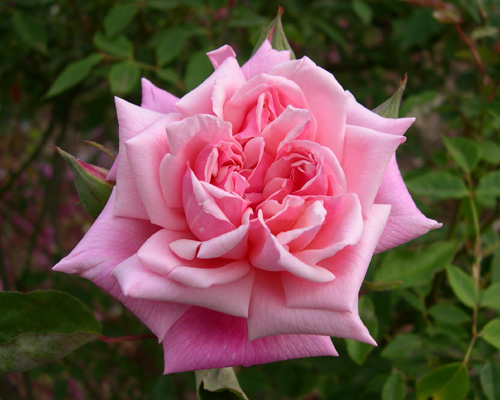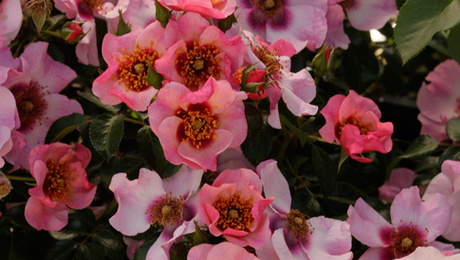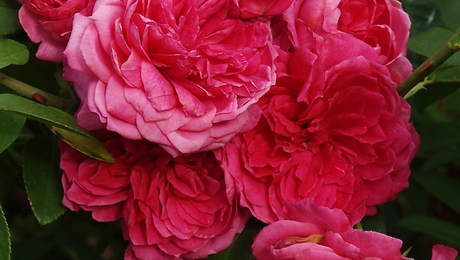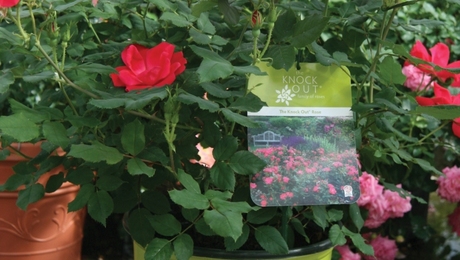Another useful way to begin searching out other garden roses is by using the rose classes as a guide. As with most things it’s not perfect but a good place to start. As always, before you make that final purchase check with other local rose growers and on the forums. To add diversity I asked Richard Beales of Peter Beales Roses U.K. to help. Richard and I put our thoughts together and we feel these classes make good Garden Roses both here and in the U.K. Some of these are modern and some as old as time itself.
Chinas – This group of roses are invaluable in that they stay on the short side – something important in today’s smaller gardens. In addition they are usually healthy, continuous flowering through the summer and have an important genealogy as ancestors to modern roses. Many do well in pots and they excel in mass plantings. In the U.S. they are hardy to zone seven and maybe a few in zone six with shelter from the wind. Mostly mail order.
Albas – A very healthy group of roses and can be used as climbers or shrubs. All are fragrant and, although spring flowering only, are very charismatic in that their grey-green foliage make perfect backdrops for summer and fall flowering perennials and roses. In terms of size they can get tall – up to six feet. They are very hardy with some withstanding zone 4. Mostly mail order.
Portlands – Our northern gardening friends rightly lament that it is difficult to find hardy, repeat flowering shrubs. Look no further because all Portlands flower continuously through the summer and most have a built in resistance to diseases. They are, without exception, fragrant and easy to grow especially in group planting or bedding. Easily hardy to zone five and some to zone four. Average height is three to five feet – ideal for any garden. Mostly mail order.
Gallicas – Also spring flowering but make up for this by having some of the most beautiful and fragrant flowers of the old garden roses. Grown as shrubs, they are usually easy to accommodate in any situation. Fans of “purple” colors will love the gallicas as that shade runs rampant through the class. Hardy to zone 4 and some even beyond. They need a winter chill to bloom well so I would advise against growing them above a zone seven and even that might be pushing it. Mostly mail order.
Hybrid Musks – A class created by the Rev. Joseph Pemberton in England this is a superb group of remontant shrub roses, almost all developed between the two World Wars. They are easy to maintain and healthy. Some are quite capable of making small, continuous flowering climbers if grown on walls or given support. They can handle to zone five and also seem to thrive in heat. A handful in garden centers and the rest mail order.
Rugosas – The roses that grow wild on the beaches of Maine in sandy soil. These must be classified as the healthiest of all roses. Almost all are fragrant and repeat their flowers in succession throughout the summer. They have durable dark green foliage and most of the single flowered varieties produce an excellent crop of bright red hips every autumn. All make superb hedging plants. Easily hardy to zone four and three one thing to keep in mind is they hate spraying of any kind on their leaves. I have also found in hotter climates it is best to plant them in a location so that by mid-day they are out of the scorching sun as it will burn their leaves. Some widely available in garden centers and the rest mail order.
Noisettes – Created in Charleston, South Carolina by a rice planter named John Champney, these are a class of mostly repeat blooming climbers with colors ranging from white through the yellows and reds. Almost without exception they are fragrant with good healthy foliage. Some of the earlier Noisettes like Mary Washington are shrubs so do some homework. It was when they became crossed with Teas that they almost all became climbers. They are hardy to zone six and some are grown in zone five in sheltered spots or with winter protection. A handful in garden centers and the rest mail order.
Ramblers of both Wichurana and Multiflora origin – Almost all have the `wow’ factor when in full bloom. Within their ranks is a complete spectrum of color. They are healthy and, if necessary, will tolerate impoverished soil and harsher weather conditions. An excellent use of these ramblers is as backdrop to repeat flowering climbers. In spring all the roses are in bloom and for the rest of the season the healthy and abundant foliage of the ramblers set off the repeat flowering roses. Easily hardy to cold climates of zone four and even lower. Mostly mail order.
Modern Shrubs – These are a group of roses that have been developed since the end of World War 11. They are of mixed progeny, almost all continuous flowering and are good where space permits them to develop their own personality. A handful can be grown as small climbers if placed against some form of support. With this group it is especially important to judge each variety individually and speak with other rose growers in your area about the ones you are thinking about trying. Almost all will be hardy to zone six with many to zone five and some to even four or lower. Size can vary from three feet to eight feet or more. Widely available in garden centers and mail order.
Floribunda Roses – These have been developed over the last 100 years or so and some of them make superb garden plants especially if grown in groups. Usually more healthy than Hybrid Teas, a few of the older varieties of quieter colors fit comfortably amongst the older roses of all types. Their smaller size of on average three to five feet, make them welcome additions to the garden. Many are hardy to zone five. Widely available in garden centers and mail order.
Species Roses – Amongst the Species are many that make superb garden plants. Although few are remontant, they are invariably healthy and most produce a superb crop of brightly colored hips. Hardiness will vary so again, check with rose growers in your area or on the internet forums. Sizes vary widely so do a little homework because when they get big, they get very big. Mostly mail order.
Tea roses – Superb Garden Roses that continually bear their blooms all season long and come in most every color found in the rose world – including bicolour. Their open growth habit and rounded shape are very pleasing in any garden setting. In warm climates some can grow to seven feet or more but generally they stay in the five foot range. They also don’t mind being regularly trimmed. They are hardy to zone seven and can handle zone six if sheltered from freezing winds. Mostly mail order.

Polyanthas – A very under used and under appreciated group of first-class Garden Roses. The smaller blooms appear in clusters all season on shrubs packed with proportionately sized foliage. Most stay under three feet and will spread as wide or more. Very healthy and easily hardy to zone five. A handful in garden centers and the rest mail order.

















Comments
Hi Paul,
This is an excellent guide to assist in searching for roses. Thanks for pointing out some great ideas.
Susan Fox
aka
http://www.gagasgarden.com
great guide, but what about grandifloras?
Log in or create an account to post a comment.
Sign up Log in